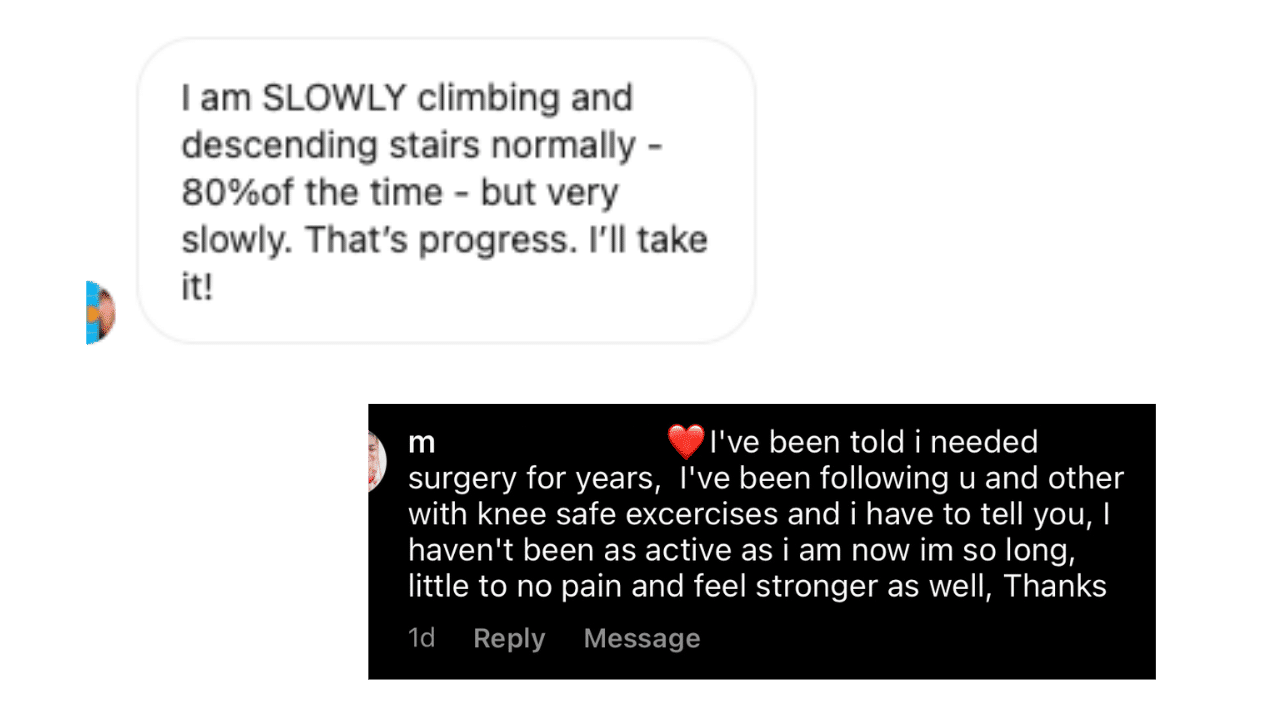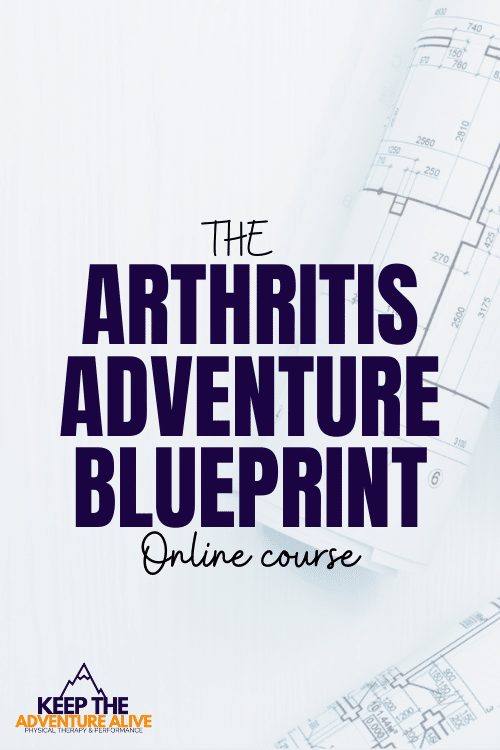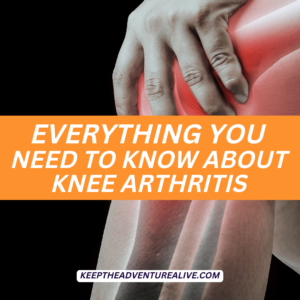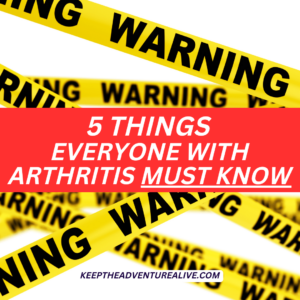There are common symptoms of knee arthritis that can point you in the direction of finding answers to your pain and guiding your treatment. Some symptoms include: morning stiffness, fluctuating swelling, pain on one side of the body, and occasional flare ups. There is no test to determine presence of knee osteoarthritis which makes these symptoms very helpful to know about. You’ll learn the common symptoms along with what to do about them if they are present below.
This post may contain affiliate links that provide us with a small compensation with no extra cost to you if you use the links in this article.
In order to figure out what is going on with your knee, take a look at these common symptoms of knee arthritis below. If you just have one of these symptoms on their own- it may indicate something else is going on. If you have a cluster of these symptoms, it could be knee arthritis.
If you do have any of these symptoms I want you to know there is absolutely hope for relief and it is not inevitable you will need a joint replacement.
In fact, here’s a podcast episode below detailing how to avoid surgery if you do in fact have knee osteoarthritis.
Please note that some of these potential symptoms of knee arthritis could point to other conditions as well so it is important to consider that in your decision.
If you do believe it is knee arthritis based on a majority of these symptoms, seeking out a second opinion is advised.
Table of Contents
1. Knee Morning Stiffness
If you wake up in the morning with knee stiffness, this is one of the hallmark signs of osteoarthritis. This usually includes feeling like you have to lift your leg out of bed and are hobbling for the first few steps.
It is important to note that after about 15-30 minutes of movement, you should experience a significant decrease in stiffness with osteoarthritis. If the stiffness hangs around for up to an hour- there is a possibility for rheumatoid arthritis (learn the difference here).
What to do about it:
Usually a few simple movements can help tremendously with this morning joint stiffness. Simply sliding your leg up and down in bed, as you increase the bend in your knee can help to get blood flowing. You can also sit on the side of the bed and kick your legs out.
Here are some examples below in this short video:
2. Gradual Knee pain
One of the primary symptoms of knee arthritis is a gradual onset of pain. Some describe it as a slight pain that appears and continues to linger as it increases in intensity. This pain is typically brought on without a specific injury.
Pain is commonly felt in the inside of the knee and/or behind the knee cap. It may even seem like the pain switches locations depending on what you are doing.
Pain felt above or below the knee joint could indicate a tendon injury to the quadriceps tendon or the patellar tendon.
Pain levels typically stay at a dull ache, especially in the beginning. They can increase depending on activity levels or degree of irritation.
One caveat to this is that if you have a history of a knee injury like an ACL tear, MCL tear, meniscus tear, or an injury that required surgery- you are more at risk for knee arthritis.
Many people try to ignore the pain at first, hoping it goes away. In this situation, pain typically tends to increase if the correct action isn’t taken, which could worsen the condition.
What to do about it:
If you begin to experience knee pain, think about when you feel it the most (i.e during a certain movement, certain time of the day, certain foods you’ve eaten, etc).
Seek out help from a medical professional you trust (here’s a post on how to choose the right doctor). It is so important to make sure you stay ahead of this pain making sure you have the right muscular support and movement mechanics to prevent making the condition worse.
Many times I notice the most pain occurs when muscle imbalances and asymmetries occur so a movement expert can help you find out what you need to work on. If you need help with this, please contact us!
3. Feelings of instability
If you have changes in your knee cartilage and/or changes in your meniscus, it can lead to feelings of instability. For example, it may feel like your knee is going to “give out” or it may buckle when all of your weight is on it.
This symptom of knee arthritis isn’t the most common but can happen depending on what is going on inside your knee and can be compounded by leg muscle weakness.
If knee instability is tied to an injury or you have a history of knee ligament repair (ACL, MCL, LCL) these can also lead to instability.
Even if it doesn’t actually give out or buckle, this is a safety hazard because it can lead to potential falls especially when on the stairs.
What to do about it:
If your knee is feeling unstable, aside from seeking out help from a medical professional you trust- you can also try a brace.
I usually recommend the soft, neoprene compression sleeves because they don’t change the way you move. Some of the braces with hard parts in them can negatively impact the way you walk.
What type of brace that will be the most beneficial for you will depend on the severity of your instability. Here is a list of my favorite neoprene compression sleeves.
4. Knee noises
Crunching, creaking and cracking in your knee can be a common symptom of knee arthritis. You may hear noises when you are going up and/or down the stairs as well as when you are squatting to sit down.
These noises aren’t inherently dangerous though. Many people believe that these noises indicate more “damage” but that is usually not the case!
I have a full post on knee noises you can check out here.
What to do about it:
If you are experiencing knee noises, there are a few things you can do to reduce the severity and the frequency. Most of which includes strengthening different muscles and moving in different ways that don’t bring more stress to the are that is creating the noise.
I have a video below that shows you the best movements to help reduce knee noises!
5. Pressure or pain climbing stairs
If you feel pressure in your knees or a dull discomfort when going up and/or down the stairs, it could be one of the symptoms of knee arthritis.
Commonly, people have most difficulty coming down the stairs with knee arthritis but can also be common in patellofemoral pain syndrome or patellofemoral arthritis, which is arthritis of the kneecap. With this type of arthritis, treatments are very similar to knee arthritis.
What to do about it:
If you have pain on the stairs, you could try going up the stairs sideways, hanging onto a stable handrail to find pain relief right now. This is a temporary fix though.
It is absolutely possible to climb up and or down the stairs with ease and confidence again though. The one primary thing that makes this possible is building leg strength. I have a Stair Climbing Secrets Video Training here that can help you get started on the right track.

6. Difficulty squatting
Squatting can feel impossible when your knees are irritated. If you feel pain as you try to do a squatting motion, if you have difficulty squatting lower, or have a hard time standing up from a chair- these all can be a symptom of knee arthritis.
It is important to note that muscle weakness is a secondary symptom to pain and muscle weakness simply does not happen just because you have knee arthritis.
If you reduce your activity levels, muscle weakness can occur- which can actually lead to more knee irritation if not addressed.
Squatting is a vital function for daily life so it is not something you have to avoid! Instead, it’s all about working around your knees and finding ways to do it that don’t further irritate them.
What to do about it:
If you have difficulty squatting, here is a post that can help explain a few common mistakes that I typically see as a physical therapist.
One of the best ways to get better at squatting is to find a variation that works for you. One of the most common ways that can be very nice to irritated, arthritic knees is to use what are called suspension straps (this is my favorite brand), Check out this video below to see how they work.
7. Fluctuating knee swelling
Knee swelling can be a very common symptom of knee arthritis especially following an additional injury like a meniscus tear, irritation after a lot of activity, and/or fluid build-up due to inactivity.
Sometimes swelling can last a few hours, sometimes it can last a few days depending on the severity of your arthritis, your activity level, presence of potential injury, how quickly your body moves fluid and/or the strength of your knee.
Swelling can also be a sign of a recent injury such as a ligament tear, meniscus tear, a fracture, or the presence of a baker’s cyst (more on that here) so it is important to rule these out first.
If you notice any other symptoms accompanying like skin warmth and redness, fever, nausea, swelling into the calf, calf pain, or increased fatigue- it is important to seek further medical care to rule out any other serious conditions.
What to do about it:
If swelling is due to knee arthritis, it is important to think about the potential cause. Ask yourself these questions:
- Did you do more activity than usual before you noticed the swelling?
- Have you significantly decreased your activity levels over the past few days?
- Have you noticed a recent flare up or increased pain?
Trying to identify the irritating factor can help to pinpoint the potential cause of the swelling. Then you can take action to mitigate it, such as spreading out errands throughout the week instead of all on one day or trying to move when sitting or standing for long periods of time.
If you are having a hard time figuring out where the swelling is coming from, moving in different ways than you usually do can significantly reduce swelling, i.e moving sideways and backwards can get different muscles moving to help pump the swelling out!
One last thing, knee compression sleeves can help to reduce swelling and keep it to a minimum- making sure that the sleeve fits appropriately. You do want to avoid sleeping in these though.
8. Feeling off-balanced
If you feel as if your balance is declining or you don’t feel as balanced as you used to, it could be a sign of knee when accompanied with other of the above symptoms.
Secondary to muscle weakness, balance can decline when you aren’t moving as much as you used to. Pain and swelling can also impact how your muscles are able to work. If they aren’t able to contract efficiently, your balance may suffer.
What to do about it:
Short and sweet but the best way to improve balance is to work on it. There are lots of ways to improve balance with knee arthritis, there are some examples in this post.
You can also check out some of my favorite balance exercises in this video:
9. Loss of flexibility
If your knee is feeling tight, stiff, or swollen you may notice that it becomes hard to bend and/or straighten your knee all the way.
Loss of range of motion is one of the common symptoms of knee arthritis but it doesn’t have to be permanent. You may notice that with limited range of motion, it becomes hard to do certain tasks such as climbing stairs, getting in/out of the car, and even walking normally.
Loss of range of motion can also occur after scar tissue build up from a previous injury or surgery as well so it’s important to rule out other potential causes.
What to do about it:
If you feel like you are losing the ability to fully bend and/or straighten your leg because of osteoarthritis- it is important to address it while preventing further loss.
This is an example of an exercise that can help address both bending and straightening. The goal would be to complete anywhere between 8-12 of these. Don’t force any range of motion, slowly start to work the muscles to improve blood flow and induce relaxation to the tight muscles.
If this one does not feel particularly good to you, don’t worry! There are tons of other ways you can work on range of motion. If you need more ideas to try and want to learn more about knee arthritis- grab this FREE guide on where to get started if you have knee arthritis.
10. Pain on one side
If you primarily notice pain in one knee more than the other, this could be on of the symptoms of knee arthritis. Most of the time, osteoarthritis develops on one side of your body. This is not to say that it isn’t possible to have it in both knees but usually it starts out in one knee.
If you have pain in both knees equally and if you notice pain in both hands, wrists, elbows, ankles, or feet- it could be a potential sign of rheumatoid arthritis. Rheumatoid arthritis typically affects both sides pretty symmetrically.
If your pain started on one knee then migrated to the other one or your other hip or even lower back- this is common as you likely change the way you move when you have pain. Compensations when you are walking, climbing stairs, and squatting are common and can lead to pain in other joints. This is why it is important to address it as quickly as you can!
What to do about it:
If you notice pain in one knee, the best thing to do is to find out what is causing your pain. It could be the way you are moving or lack thereof, it could be the foods you are eating, it could even be the stress you are feeling.
Honestly, it’s likely a combination of a few things. But, almost everytime you go see a medical professional for your knee, they usually only look at your knee! Taking x-rays and moving your knee around.
I find SO OFTEN that with osteoarthritis many people are chasing the wrong solutions to find relief. Instead it’s important to find the root cause- that’s how you make pain relief last.
I created the Arthritis Adventure Blueprint to give you a step by step process on exactly how to figure out what is causing your pain and how to fix it because many times you don’t get the answers you are looking for from traditional healthcare.
I have met so many people with osteoarthritis who have been chasing pain relief for years without any success in finding it. Instead of you wasting your time weeding through so much information, I gathered everything you need, right in one spot.
Learn more about the blueprint
11. Pain flares
If you notice intermittent bouts of higher levels of pain, swelling, and/or stiffness that appear to “come out of the blue” this could be what’s called an osteoarthritis flare up.
Sometimes they can be triggered from too much activity, too little activity, eating lots of inflammatory foods, changes in weather or even with high amounts of stress. They can also spontaneously occur.
Either way, these flare ups are typically temporary. They can last up to 5-6 days depending on the cause and what you do to find relief.
What to do about it:
If you notice a flare up in pain, it is important to understand what can help to reduce this pain so it doesn’t derail your entire day!
There are lots of tools you can use to help with immediate pain relief that are explained in this video below. Some include gentle movement, certain pain creams (Voltaren is a common one), heat/ice, and others.
When it comes to a pain flare up, you do want to take action to reduce the pain. Laying on the couch and resting isn’t always the best way to find relief.

The Arthritis Adventure Blueprint
Dr. Alyssa Kuhn’s signature program to help you go from hopeless to hopeful with osteoarthritis. You will learn the secrets to arthritis pain relief that actually work- including exercise, diet, and other ways to control inflammation! Say goodbye to short term pain relief, it’s time to make it last.
Disclaimer: This post is for general informational purposes only. It should not be used to self-diagnose and it is not a substitute for a medical exam, cure, treatment, diagnosis, and prescription or recommendation. It does not create a doctor-patient relationship between Dr. Kuhn and you. You should not make any change in your health regimen or diet before first consulting a physician and obtaining a medical exam, diagnosis, and recommendation. Move Well Age Well, LLC and Dr. Alyssa Kuhn, PT, DPT are not liable or responsible for any advice, course of treatment, diagnosis or any conclusions drawn, services or product you obtain through this post, video or site.




